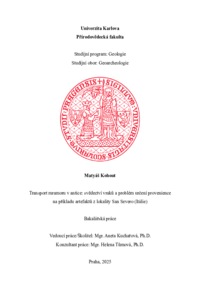Transport mramoru v antice: svědectví vraků a problém určení provenience na příkladu artefaktů z lokality San Severo (Itálie)
Marble transport in Antiquity: evidence of shipwrecks and the problem of provenance determination using artefacts from San Severo (Italy)
bachelor thesis (DEFENDED)

View/
Permanent link
http://hdl.handle.net/20.500.11956/199820Identifiers
Study Information System: 274989
Collections
- Kvalifikační práce [20838]
Author
Advisor
Referee
Přikryl, Richard
Faculty / Institute
Faculty of Science
Discipline
Geoarchaeology
Department
Institute of Geochemistry, Mineralogy and Mineral Resources
Date of defense
3. 6. 2025
Publisher
Univerzita Karlova, Přírodovědecká fakultaLanguage
Czech
Grade
Excellent
V antice byl bílý mramor těžen v západním, centrálním i východním Středomoří. Ovšem hlavní těžební lokality se mimo severozápadní Itálii koncentrovaly především v oblasti Egejského moře. Geografická nerovnoměrnost zdrojů mramoru podmínila intenzivní zámořské obchodní plavby. Vraky římských nákladních plavidel ilustrují jak enormní poptávku po východomediteránních mramorech za cenu risku plavby v nebezpečnějších vodách, tak i obraz antických obchodních tras širší optikou. Tato bakalářská práce se soustředí na problematiku transportu bílého mramoru v antice (především v době římské a pozdně antickém období) a otázku analýzy jeho provenience. Rešeršní část je zaměřena na římské obchodní trasy ve Středomoří a trendy v otázce distribuce lodních vraků. Dále jsou představeny hlavní těžební lokality v Mediteránu, odkud byl mramor v antice získáván; jejich historický/archeologický kontext, geologické pozadí a mineralogicko- petrografické a geochemické charakteristiky. Následující kapitola popisuje tři vybrané příkladové studie vraků plavidel transportujících mramor nalezených na pobřeží jižní Itálie. Závěrečná kapitola teoretické části představuje komplexitu analýzy provenience mramoru a jmenuje nejpoužívanější analytické metody této archeometrické disciplíny. Zájmem experimentální části této práce je...
In ancient times, white marble was exploited in western, central and eastern Mediterranean. Nevertheless, main quarries apart from the north-west Italy were concentrated primarily in the region of Aegean Sea. The uneven geographic distribution of sources led to intense maritime shipping. Roman merchant shipwrecks depict not only an enormous demand for marble from eastern Mediterranean at cost of great risk by sailing in dangerous waters, but also the picture of marble trading routes as a whole. This bachelor's thesis deals with the issue of transport of white marble in antiquity (mainly in the Roman period and Late antiquity) and its provenance analysis. The theoretical part focuses on the Roman trade routes in Mediterranean and trends regarding the distribution of shipwrecks. Next, main quarry sites in Mediterranean from which the marble was obtained are presented, including their historical/archaeological context, geological background and mineralogical-petrographic and geochemical characteristics of marbles. Following chapter describes three selected exemplary studies of shipwrecks of vessels transporting marble found on the coast of southern Italy. The last chapter of theoretical part deals with the complexity of marble provenance analysis and names the most frequently used analytical methods...
